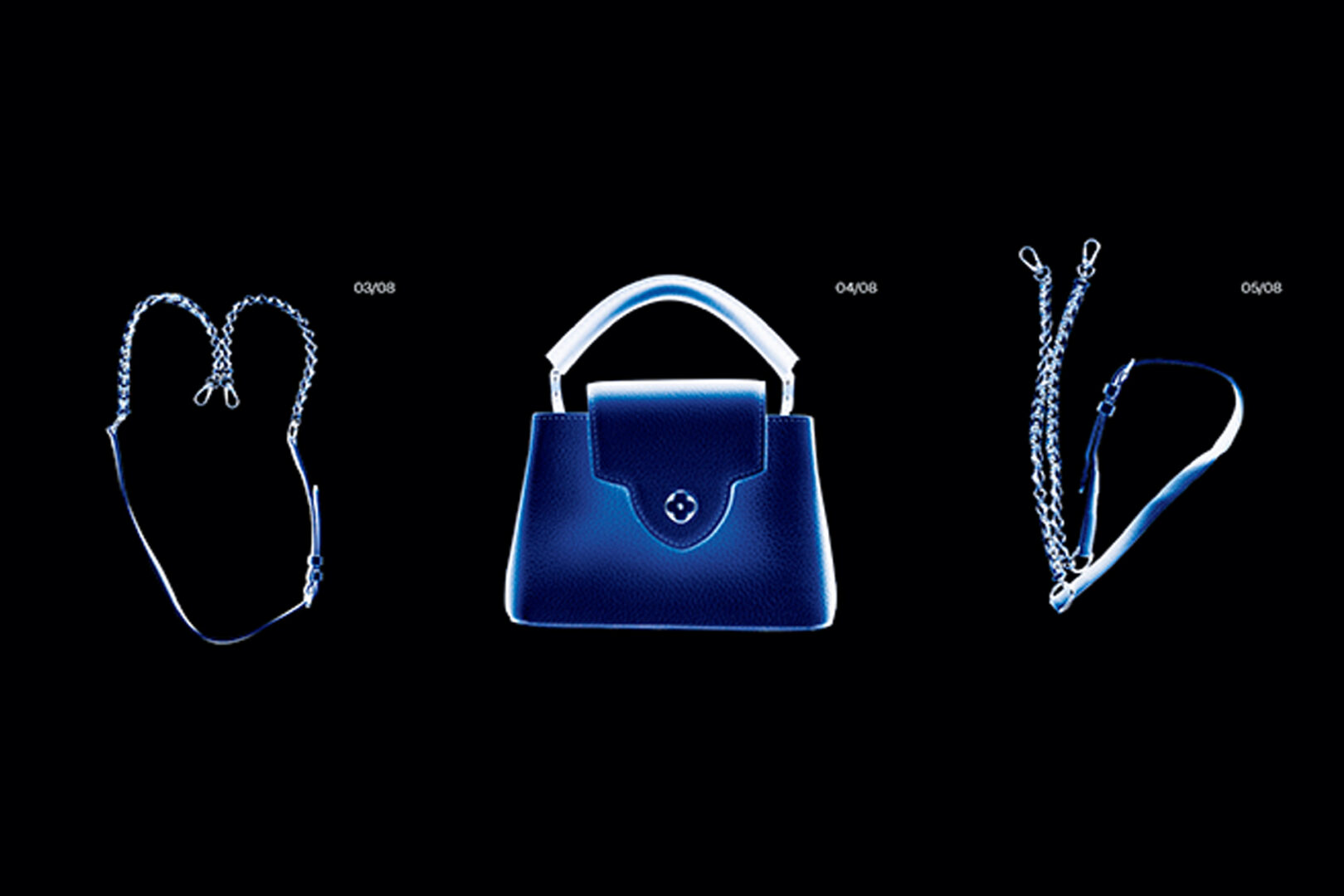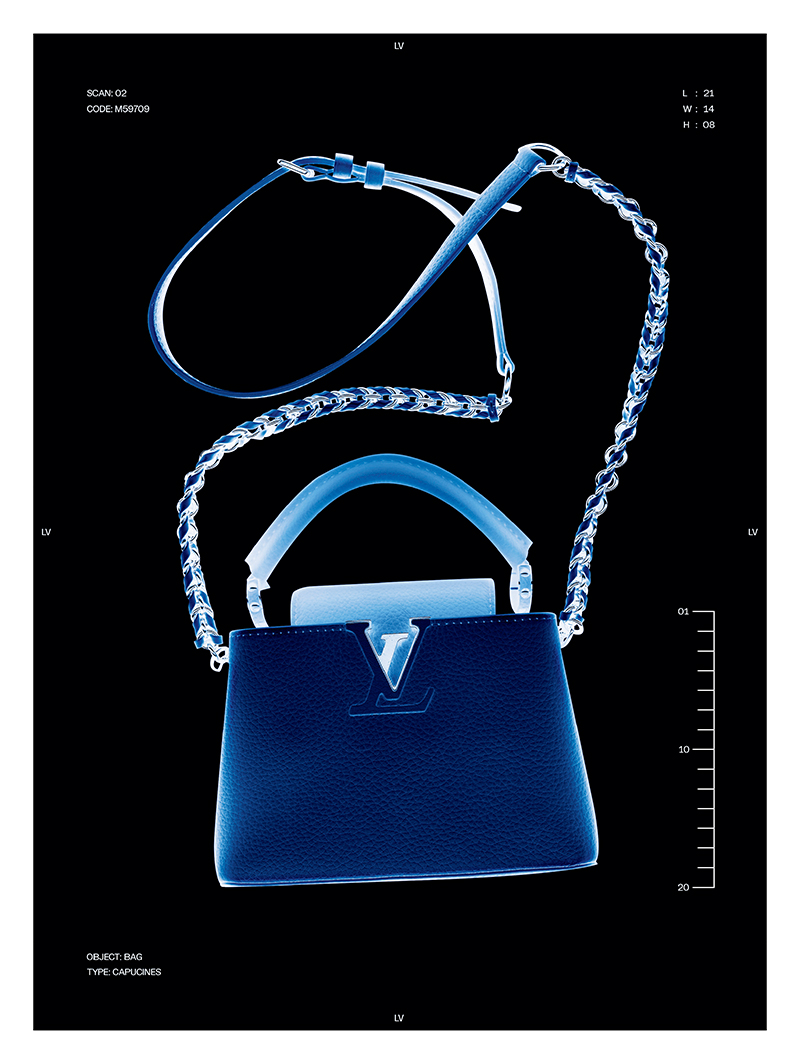Up to 300 people working in a single workshop; divided into two areas to encourage a sense of community and the transmission of skills from generation to generation
Louis Vuitton design reversal to establish an aesthetic
Back in the nineteenth century, Louis Vuitton used design reversal to establish an aesthetic, as opposed to the decorative intensity of the time. With the flat shape of their lids, this made the trunks easier to stack. Trunks were made in poplar wood. Chosen for its easy-to-work pulp, lightness, and durability. Reinforced with beechwood staves; covered with an impregnated canvas painted in oils in a medium-light shade of gray, the Gris Trianon. It would take years before the iconic Monogram canvas first appeared in 1896. After making trunks designed for the narrow spaces of railway trains, Vuitton anticipated the advent of motor vehicles. In 1897, unveiled the first model of a trunk for cars, designed to be stored inside or outside the passenger compartment.
This was followed by the roof trunk and driver’s bag, the Aéro and Aviette. An ultra-light chassis suitcase, for aircraft limiting excess weight. For instance, each piece of luggage was protected by a patented lock with an anti-break-in mechanism. An irreproducible numbered key that allowed all the luggage belonging to the same owner to be opened. From the very beginning, Vuitton has had to face imitations and counterfeiting attempts; trunks were imitated in upholstery materials by competing artisans to the point when, in 1888, the brown and beige checkered Damier canvas with the words ‘L. Vuitton trademark registered’, became the lever to discourage counterfeiting and reaffirm the authenticity of Vuitton items.
A history of innovation
Louis Vuitton has an established legal department and an annual budget of 15 million euros earmarked for counterfeiting matters. The ‘zero-tolerance’ policy is a long-term element of Louis Vuitton’s worldwide strategy. Its website states: «The robbery of intellectual property rights undermines the investment and knowledge made to develop the company. Counterfeiting damages communities with uncontrolled and dangerous working conditions and abuse of human rights such as under-aged and forced labor».
Protecting the brand, Louis Vuitton safeguards the interests of its customers but also its employees. In an age that celebrates artificial intelligence automation and encourages immersion in digital realities, Louis Vuitton’s workshops prove the value of handcrafts. While on the one hand, the brand values its French heritage and local traditions. On the other, it is not constrained by geographical nationalism. It looks to where the tradition of manufacture is still alive; as chief executive Michael Burke tells of the process of opening a new workshop.
«This is where the talent is, a pool of talent, transmitted from generation to generation. The watchmakers are in and around Geneva; the tanneries are outside Florence; the high-end shoe manufacturers are in Veneto, and the silk businesses are around Como». The preservation and perpetuation of skills still leads the manufacture of Louis Vuitton products today in the workshops located in France, Italy, Switzerland, and Texas (USA).
Know-how and skill – Louis Vuitton
Up to 300 people can work in a single workshop; divided into two areas to encourage a sense of community and the transmission of skills from generation to generation. While the brand travels beyond French borders when looking for the best quality manufacturers, Louis Vuitton has also played a key role in retaining France’s jealously guarded and centuries-old savoir-faire. «Had we not insisted on making the great majority of our leather goods in France thirty years ago; leather goods manufacturing would have moved to Italy. Just as silk left Lyon and went to Como, and watchmaking left France and established itself in Switzerland», explains Burke.
In 2019, Vuitton stated its commitment to ensuring that 100 percent of their raw materials would be responsibly sourced and from supply chains that have a regenerative impact on biodiversity. Furthermore, this would mean that all leather goods would comply with the global Leather Working Group (LWG). Today, 80 percent of Vuitton’s leather is LWG certified, and by 2025, Louis Vuitton aims to achieve 100 percent certification mark and 0 percent single-use plastic by 2030.
According to their sustainability reports, 70 percent of their materials are in a certification process; 52 percent are already certified under the strictest of standards to meet sourcing requirements. Showcasing savoir-faire and craftsmanship, Louis Vuitton perpetuates the trunk-making traditions of its founder, with thirteen workshops across Europe and the United States.
Back to france: leather and couture
Beyond the manufacture of bags and leather accessories, these also include the artisanal production of watches, jewelry, shoes, and perfume. Most of the factories are located in France, between Paris and Asnières. It is at the Asnières atelier that artisans produce the brand’s rigid luggage. Located near Paris to ensure fast delivery of raw materials by rail and river systems; the site was designed according to the modern architectural principles of the time. With a glass and metal structure in Gustave Eiffel’s style. Today it is still used for all special orders and travel products.
It is here that the fifth-generation of the Vuitton family grew up and worked in the factory. As Patrick-Louis Vuitton (1951-2019) recalled, he spent his childhood ‘a hop and skip away from the workshop’. He later became an apprentice, encouraged by his grandmother, Madame Gaston-Louis Vuitton, who requested that he start out as a simple carpenter assistant in the Seventies, to work his way up the ladder through every post at the atelier. To nurture savoir-faire, the brand – along with its parent group LVMH – founded the Institut des Métiers d’Excellence LVMH; to ensure the transmission of the Maison’s techniques, based on the mentorship model.
The lack of qualified artisans is an issue, and this program aims to improve the employability of apprentices. The IME currently offers thirty-one courses in creative, craft, and retail professions across France, Switzerland, Italy, Spain, and Japan; twenty-nine of which have a work-study format. The institute promotes and passes on the savoir-faire of the industry in craft métiers. It enables the recruitment and training of young people, while facilitating recruitment by the LVMH Group, its partners, or companies seeking qualified staff with the different specialized skills taught.
Fine perfumery and Grasse heritage
In Grasse, is Les Fontaines Parfumées, an estate designed by the landscape architect Jean Mus. Dedicated to fine perfumery and perfume creation. Inaugurated by Bernard Arnault in 2016; it combines the savoir-faire of perfume, from the flower to the bottle, within a single ecosystem. Jacques Cavallier-Belletrud is the Master in-house perfumer at Louis Vuitton. Grasse has been the capital for the raw materials and art of perfume for almost five centuries.
«This domain was sleeping until Louis Vuitton arrived. We had to be in Grasse, because the ‘fil’ of Louis Vuitton. has to be close to the place where you have the best craftsmanship. For perfume and its ingredients, it’s Grasse. If too advanced, nobody understands what you’re doing. If you’re too close to what already exists, there is no interest. The border between success and disaster is thin. I can have the idea, but the real work is to put it in a Louis Vuitton bottle».
A mindset in each and every craftsperson
Whether in the couture ateliers in Paris and Geneva, or in the atelier next to the abbey in Vendôme where they polish alligator hides. If for fine perfumery Louis Vuitton chose Grasse, then for fine watches it made sense for the brand to move to the capital of watchmaking, Geneva.
La Fabrique du Temps, a bright and open 4,000 square meter factory equipped with both traditional craft tools as well as advanced digital technologies, has gathered all the horological métiers in one site, since 2014. From the creation of its first model – the Tambour – in 2002; The making of Louis Vuitton watches was in Switzerland using miniature hand-painting, fine stone inlaying, and gem-setting. Moving South-East from Geneva and passing over the Alps is the Italian footwear district of Venet where Louis Vuitton produces shoes.
Switzerland and Italy: the time and the shoe factories
In Fiesso d’Artico, along the Riviera del Brenta between Venice and Padua, is the Manufacture de Souliers. Encompassing all the techniques of fine shoemaking, the modern white building also houses an art gallery for exhibiting creations of the Maison and works of art, as well as a library dedicated to shoes. Designed by architect Jean-Marc Sandrolini in 2009, the factory is a 14,000-square-meter space resembling a cement shoebox from the outside; revealing an open space with a giant white heel designed by Jean-Jacques Ory and featuring a custom trunk from 1909 inside.
Four different workshops compose the facility. Alma, dedicated to women’s shoes; Speedy, dedicated to sneakers; Nomade, dedicated to car shoes; and Taiga dedicated to elegant men’s shoes and leather goods, such as belts. A warehouse named after the Louis Vuitton Neverfull bag. Therefore, in the Fiesso d’Artico factory, artisans train for years to master their craft. Some studied at the Institut des Métiers d’Excellence LVMH and combined centuries-old methods with modern technology. I.e., starting with a wooden prototype later scanned into a 3D CAD model.
The U.S. journey: The Rochambeau ranch
Rochambeau ranch in Texas, U.S., an ultramodern workshop designed for leathercrafting. It all began when Burke decided to open a new factory for leather goods in the U.S.. Here the brand had been manufacturing since 1955. The Rochambeau Ranch, named after the Comte de Rochambeau who assisted George Washington during the War of Independence. It was the perfect location to honor the relationship between France and the U.S.
Goods crafted to French standards, but also imbued with American culture. The Rochambeau Ranch is the only Louis Vuitton workshop to have a barbecue pit and an onsite cowboy, Randy, who takes care of the horses, the cattle, and the land. Furthermore, from Paris to Normandy, Louis Vuitton has built manufacturing facilities dedicated to handbags, exotic leathers, jewelry, prêt-à-porter, and haute couture, choosing unique locations rich with heritage, historical interest or outstanding natural beauty to house their workshops.
In Normandy, you can see Mont Saint-Michel from the workshop. For their architectural interest, these factories have even become attractions in and of themselves; as in the South-West of France, where the workshops in Marsaz became famous because it’s the largest planted roof surface in Europe. In September 2020, the Maison opened an exotic skins workshop in an ancient abbey in the historic center of Vendôme: artisans moved into a noble building, once home to a monastic order.
Louis Vuitton Manufactures
A book by Nicholas Foulkes and published by Assouline. It showcases the locations and buildings of Louis Vuitton’s ateliers and the artisans who work at Louis Vuitton’s creations. The volume features photographs commissioned exclusively for the book. From the workshops in France to Geneva (Switzerland), Fiesso d’Artico (Italy), and even Texas (USA); offering an overview of Louis Vuitton ateliers, artisanal savoir-faire, and traditional techniques.




















